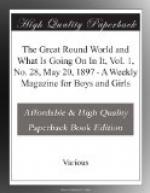I was interested about Princess
Charlotte of Belgium. I hope you
will tell us more about her.
I hope that Cuba will gain
her liberty, and that Crete will free
herself from the rule of Turkey.
I think that King George of
Greece is a very nice man, and I
hope that he will keep the
Powers from interfering with Greece.
The kindergarten for the blind
is in Jamaica Plain, very near
us, and last week I went to
an exhibition there.
Sometimes I visit the kindergarten,
and I have often seen the
girls knitting and sewing.
Our teacher, Miss Cushman, takes the great round World. She lends it to the girls who do not take it, and they find out about Crete and Greece. We are studying about the Eastern Question, and your magazine helps us to find what we want. Do you know any more about the big python that was found in Florida, or was it just taken to the Smithsonian Institute?
Will you please send me a “Who? When? What?” Chart?
Your devoted
reader,
Fanny R.H. (aged
12.)
Brookline, mass.., April 28th, 1897.
DEAR FANNY:
Many thanks for your kind letter. We have heard nothing further about the python. We understood that it was to be stuffed for the Institute.
Editor.
Dear editor:
Will you please publish an account of the phonographic graphophone—its invention, when, and by whom? We have recently had a concert by this wonderful invention, and I am requested to get all the information I can from whatever source I can. The great round World, which is read every morning in our schoolroom, is so much appreciated by all that I am sure my schoolmates will be pleased to see your reply. I shall be glad to get this information as early as possible.
Very
respectfully,
Lucy
F.
Brent, GA., April 28th,
1897.
MY DEAR LUCY:
The graphophone is an improved phonograph, the cylinder being of hard rubber instead of wax.
The phonograph was invented by Thomas A. Edison in 1877, and improved by him about 1889.
It operates by means of a thin diaphragm set in vibration by the voice or any other sound. It bears a stylus which records the vibration, on a rotating, wax-coated cylinder, in a faint wavy line.
This line is sufficient, however, to guide the stylus over the same course again, and agitate the diaphragm into reproducing waves of sound, similar to those originally recorded.
The Editor is very much obliged to Dallas S. for his
pleasant letter.
Editor.




